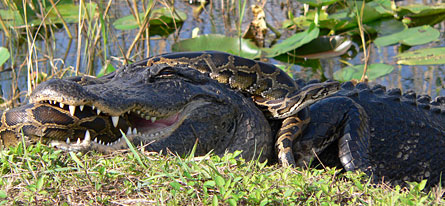Giant snakes warming to U.S. climes
Some were pets whose bodies and appetites apparently got too big for their owners to support. Most are probably descendants of released pets. Today, thousands of really big non-native snakes — we’re talking boa constrictors, anacondas and pythons — slither wild in southern Florida. And there’s nothing holding them in the Sunshine State. Which is why a report that was released today contends they pose moderate to high ecological threats to states on three U.S. coasts.




Indeed, the homelands of these snakes share climatic features with large portions of the United States — territory currently inhabited by some 120 million Americans. Based on comparisons of the temperatures, rainfall and land cover found in the snakes’ native range, it’s possible that these slithering behemoths could stake claims to territory as far north as coastal Delaware and Oregon. Or so Gordon Rodda and Robert Reed of the U.S. Geological Survey observe in a 300-page assessment. As North America’s climate warms, the two predict, these invaders might even expand that range — by the end of this century becoming permanent residents of the Midwest.
Except for the relatively diminutive boa constrictor, which may reach four meters in length,the constrictors dealt with in the new report — and commonly imported into the U.S. pet trade — can easily exceed six meters. Rodda and Reed report that three of the species that they focused on are already reproducing in the Everglades and other portions of south Florida: the boa, Burmese python (Python molurus bivittatus) and Northern African python (Python sebae).
Of these, the Burmese python appears most entrenched in Florida’s wilds. In 2000, the National Park Service removed two of them from the Everglades, and three more a year later. Since then, the number of culled pythons has been increasing annually. Last year, 343 were pulled from the Everglades. As of last week, this year’s tally had reached 270.
But no one thinks these removals are making much of a dent in the growing emigrant populations.
The species is now believed to inhabit thousands of square miles of south Florida, USGS says, and its best guess is that they number in the tens of thousands. Finding them is challenging. “Detection probabilities for the Burmese Python in the Everglades are on the order of 1 in 1,000 per day, meaning that only a tiny fraction of the population can be found on demand,” Rodda and Reed say. This species is also quite fecund. In their native range, females can fill a nest with as many as 100 eggs. In Florida, two recent clutches were discovered with 79 and 85 eggs.
This species is one of the fastest growing of all snakes and can begin breeding at just a few years old. These pythons can ultimately live to age 30 and consume meals of animals that might seem too big, mobile or aggressive to make a desirable entrée, such as leopards, alligators, porcupines, antelope and jackals.
The Burmese python is also fairly flexible in its real estate needs. It can inhabit temperate or tropical climes, both arid and very wet environments. And by hibernating, it can successfully overwinter in regions that average just a few degrees above freezing.
You can download the full USGS report to find out about the other snakes and why Rodda and Reed think they also pose a clear and present danger to U.S. ecosystems, especially across the southern United States.
The big issue is that these snakes have few predators in their native range and none in the States. Their U.S. prey — typically birds, reptiles, mammals, frogs, snakes and members of the gator family — have never learned to coexist with these big stalkers. Animals that lay in wait for hours until their prey comes by. Snakes that then grab and gradually apply a squeezing death grip. These giant constrictors can hunt day or night, from trees or land or water.
It would be nice to think we could control the release of these ecologically troublesome predators by restricting their importation. But the new report says that domestic farming of these snakes, while “undocumented,” is believed to be substantial. “For Burmese Pythons in particular, the domestic production is judged to be as large or larger than importation.”
Right now, most of these giant snakes reside in coastal areas. But not being finicky diners, they can probably survive almost anywhere within their climatic limits, Rodda and Reed say. Last year, they mapped suitable regions, based on matching current local climates within the United States against conditions in the snakes’ home ranges (see map below). If a climate warming continues, they project that by 2100 these snakes — especially the cold-tolerant Burmese python —may be established in parts of Washington state, Colorado, Illinois, Indiana, Ohio, West Virginia, Pennsylvania, New Jersey and New York.
Of course, eradication is always an option, if there’s plenty of time and money — and willingness to slog through potentially infested waters and high grass. Or maybe we should just develop a cookbook of to-die-for recipes that call for these snakes. History has taught us that humans have a good track record of being able to hunt to the brink of extinction any popular species.
However, I’m guessing that neither Reed, a herpetologist, nor Rodda would warm to the idea of throwing anaconda steaks on the backyard grill.
“We can testify to these snakes’ attraction personally,” the scientists say, “as we both have kept pet giant constrictors. We can attest to these snakes’ beauty, companionability, and educational value. The love of nature is often originally fostered in one’s own arms, where close contact with living things engenders a connection not otherwise possible. And size does impress. Thus the social value of protecting native ecosystems must be weighed against the social value of fostering positive attitudes about the protection of nature through giant constrictor ownership.”







